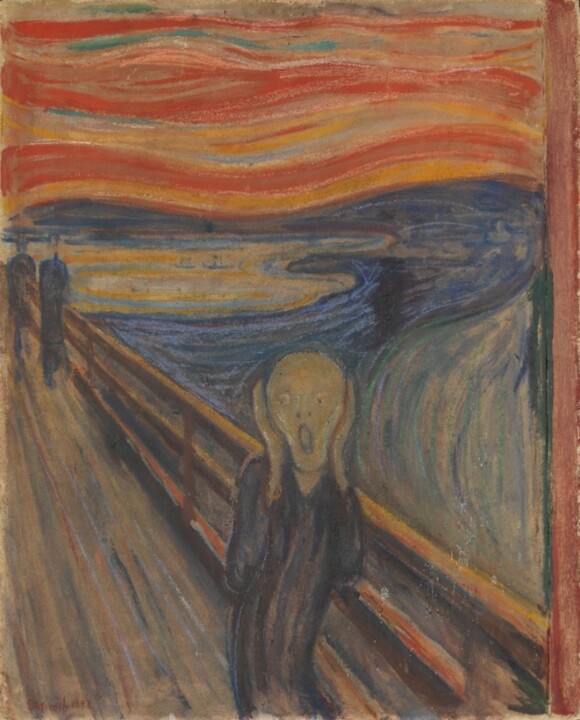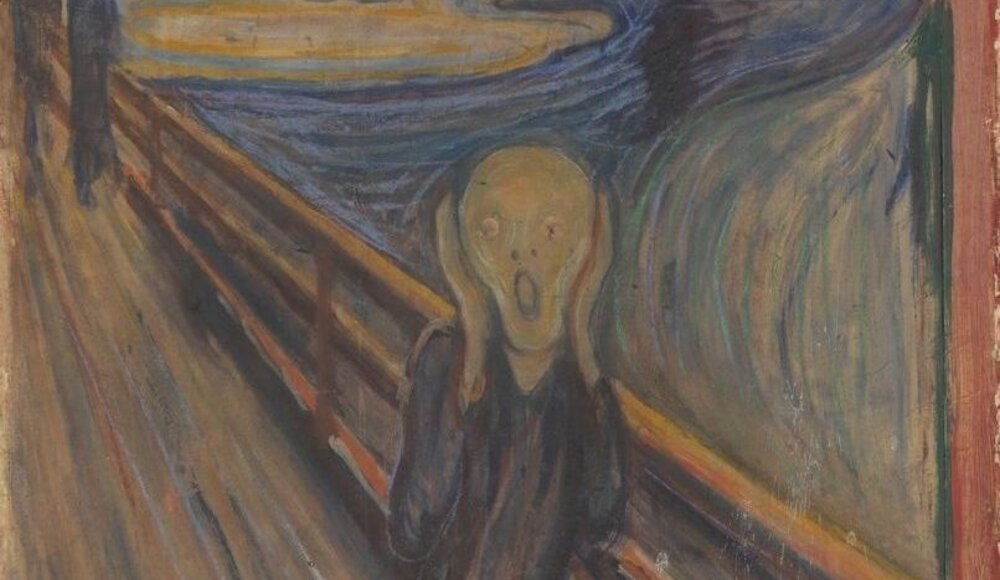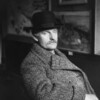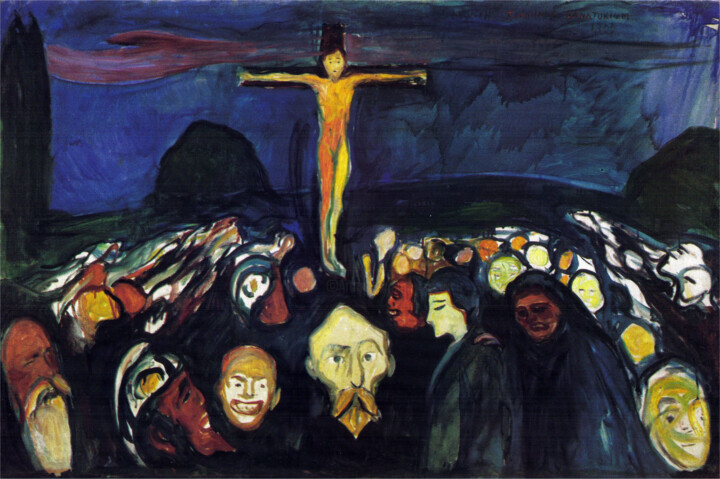 Edvard Munch - The Scream, 1893. Tempera and wax crayon on board, 91 x 73.5 cm. National Museum of Art, Architecture and Design, Oslo, Norway.
Edvard Munch - The Scream, 1893. Tempera and wax crayon on board, 91 x 73.5 cm. National Museum of Art, Architecture and Design, Oslo, Norway.
Who was Edvard Munch?
Edvard Munch was a Norwegian painter and printmaker who lived from 1863 to 1944. Munch was born in Løten, Norway, and grew up in Oslo. He studied art in Oslo and Paris, and was deeply influenced by the Symbolist movement and the work of artists such as Paul Gauguin and Vincent van Gogh. He is best known for his emotionally charged and psychologically intense works, which often explored themes of love, death, and existential angst.
Munch's early work was marked by a sense of darkness and despair, reflecting his own personal struggles with illness, poverty, and loss. He gained recognition in the 1890s with a series of paintings known as the "Frieze of Life". Munch used the name "The Frieze of Life" to describe a series of paintings created between 1893 and 1917, that explored the themes of love, illness, and death. This category includes well-known works like "The Scream", "Madonna", "Vampire", "Angst", "Melancholy", "Death in the Sickroom", among many others. The series depicts the stages of an individual's existence from birth to death, and is widely regarded as one of Munch's most important works.
The series is divided into four parts: "The Childhood of Man," "The Life of Man," "Love," and "Death" and each section contains several paintings. "The Frieze of Life" was inspired by Munch's own personal experiences and struggles, including the deaths of several family members and his own bouts of illness and depression. The series is notable for its powerful emotional content and vivid, expressive style, which often uses bold colors and distorted forms to convey a sense of intense psychological turmoil.
"The Frieze of Life" has had a significant impact on the development of modern art, influencing a number of artists and movements, including Expressionism and Surrealism. The series continues to serve as evidence of Munch's enduring legacy as an artist and his dedication to using his work to explore the most profound facets of life experiences.
Throughout his career, Munch continued to experiment with new styles and techniques, including woodcuts and lithography. He also created a number of public murals, most notably for the University of Oslo.
Munch's work had a significant impact on the development of Expressionism and other modern art movements, and continues to be admired and studied today. His most famous work is likely "The Scream," a painting that has become an iconic symbol of human anxiety and existential despair.
 Edvard Munch - Self-Portrait. Between the Clock and the Bed, 1940-1943. Oil on canvas. 149.5 x 120.5 cm. Munch Museum, Oslo, Norway
Edvard Munch - Self-Portrait. Between the Clock and the Bed, 1940-1943. Oil on canvas. 149.5 x 120.5 cm. Munch Museum, Oslo, Norway
The Scream
"The Scream" is a famous painting created in 1893. The inspiration for the painting came from a personal experience that Munch had while walking along a fjord in Oslo, Norway. As he walked, Munch later wrote in his diary, he felt a "great, infinite scream" pass through nature. He felt as though the natural world around him was imbued with a sense of anxiety and terror, and that this feeling was reflected back at him. The painting is meant to capture this sense of existential dread and anguish, with the central figure in the painting appearing to be in the throes of a scream or a cry of despair. The background of the painting, with its swirling clouds and red sky, adds to the overall feeling of unease and tension.
Munch is known for his emotionally charged and psychologically intense works, which often explored themes of love, death, and existential angst. "The Scream" is widely regarded as an iconic representation of human anxiety and existential dread, and has become one of the most recognizable works of art in the world. The anguished figure in the painting has been interpreted as a representation of the modern individual's isolation and sense of despair in the face of an uncaring and indifferent universe.
Versions of The Scream
Edvard Munch created several versions of "The Scream" over the course of his career. Here are the most notable versions:
- 1893 Painting: The most famous version of "The Scream" is a painting created in 1893 using oil, tempera, and pastel on cardboard. This painting is housed in the National Gallery of Norway in Oslo.
- 1893 Pastel: Munch also created a pastel version of "The Scream" in 1893. This version is considered the most vibrant and expressive of all the versions and is housed in a private collection.
- 1895 Painting: In 1895, Munch created another version of "The Scream" using oil on canvas. This version is housed in the National Gallery of Norway in Oslo.
- 1910 Painting: In 1910, Munch created a fourth version of "The Scream" using tempera on cardboard. This version is considered the most somber and introspective of all the versions and is housed in the Munch Museum in Oslo.
Each version of "The Scream" has its own unique qualities and nuances, but all of them share the same haunting imagery and emotional intensity.
In popular culture
"The Scream" has had a significant impact on popular culture. It has been referenced and parodied in numerous movies, TV shows, advertisements, emoji and other forms of media. “The Scream" has been the subject of numerous reproductions and adaptations in popular culture, including parodies, advertisements, and even emoji. It remains one of the most recognizable and widely reproduced works of art in the world.
One of the most famous references to "The Scream" is in the movie Home Alone, in which the character Kevin McCallister places his hands on his face and screams in a pose reminiscent of the painting. The image has become iconic and is often used in comedic contexts to indicate frustration or panic.
In the TV show The Simpsons, there is an episode in which the character Marge Simpson is being chased by a giant version of "The Scream." The painting has also been referenced in other TV shows like Futurama and The Office.
The artwork has also been referenced in music, with musicians such as Pink Floyd, Eminem, and Björk incorporating images of "The Scream" into their album covers and music videos. For example, the band Radiohead used a version of "The Scream" as the cover art for their album Kid A, and the music video for Madonna's song "Frozen" features imagery inspired by the painting.
"The Scream" has also been used in advertising campaigns, such as a campaign for M&M's candy where the candies are shown screaming in the same pose as the central figure in the painting.
The painting has been parodied and reimagined in countless ways, with versions of the painting featuring popular cartoon characters, celebrities, and even animals.
Overall, "The Scream" has become an enduring symbol of disturbing and existential angst in humanity, inspiring countless adaptations and interpretations over the years.
The Scream’s criticism
"The Scream" by Edvard Munch has been the subject of much critical analysis and interpretation over the years. Here are some of the most notable criticisms of the painting:
- Lack of technical skill: Some critics have argued that Munch's use of bold, expressive brushstrokes and distorted forms demonstrates a lack of technical skill and artistic finesse.
- Overexposure: "The Scream" has become such an iconic image in popular culture that some critics argue that its true meaning and significance have been diluted by its overexposure.
- Lack of specificity: The figure in "The Scream" is not clearly defined or specific, leading some critics to argue that the artwork is overly ambiguous and lacks a clear narrative or message.
- Derivative of other artists: Some critics have argued that "The Scream" is derivative of other artists and movements, such as Expressionism and Symbolism.
Despite these criticisms, "The Scream" remains one of the most celebrated and iconic works of art in the world. Its powerful emotional content, vivid imagery, and enduring legacy continue to inspire and captivate audiences around the world.


 Selena Mattei
Selena Mattei





